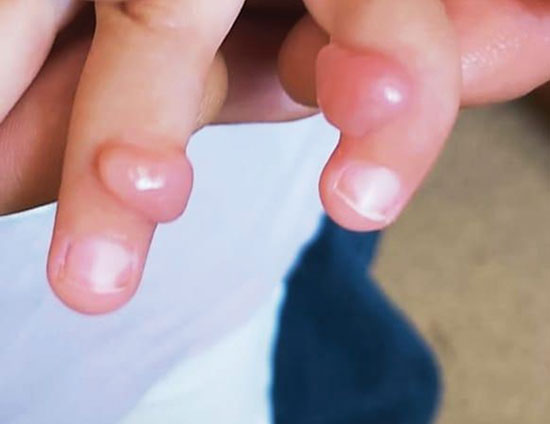|
|
|
Indian Pediatr 2021;58: 1104 |
 |
Infantile Digital Fibromatosis
|
Zeynep Canan Özdemir,* Ersin Töret
Department of Pediatrics, Division of Pediatric
Hematology/Oncology, Eskişehir Osmangazi University Faculty of
Medicine, 26480, Meşelik Campus, Eskişehir, Turkey.
Email: [email protected]
|
|
A 6-month-old female patient presented with
swelling in a finger of the left hand. Physical examination
revealed a 1x1 cm firm, painless, nodular mass on the medial
aspect of the distal phalanx of the fourth finger. On
pathological examination of the excised mass, the patient was
diagnosed as infantile digital fibromatosis (IDF). Nine months
later, soft tissue masses of 1x1 cm formed at the operation site
and also on the posterolateral surface of the distal phalanx of
the third finger (Fig. 1). No treatment was administered
since the tumor had a benign character, recurred after surgical
treatment, and did not cause pain or loss of function.
 |
|
Fig. 1 Skin-colored firm nodules
on the distal phalanx of the third and fourth fingers.
|
Skin and subcutaneous nodules that occur
among infants are typically benign, but malignant lesions like
rhabdomyosarcoma, fibrosarcoma, neuroblastoma and congenital
leukemia, may occur as well. IDF is a rare benign childhood
tumor that presents almost exclusively in the fingers or toes.
The lesion is typically firm and painless and presents on the
dorsal, lateral, or ventral aspect of a finger as an
erythematous or skin-colored, solitary papule less than 2 cm in
diameter. Medical or surgical treatment may be required for
lesions causing functional impairment. In medical treatment,
topical steroids, intralesional steroids and topical tacrolimus
treatment are applied. Recurrence occurs in 60-75% following
surgical excision. As the lesions regress spontaneously over
several months to years, observation is recommended in cases
without pain or dysfunction.
|
|
|
 |
|

